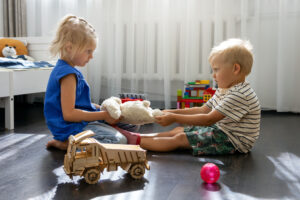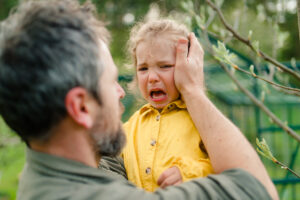-
Why you should Teach your Kids about the Importance of Education

Father and daughter reading books.
Education Begins at Birth
From the moment they arrive, children are learning. Little children soak in knowledge like sponges, and if you think about everything they learn and accomplish in the first few years of life, it’s really very impressive. Most little ones are innately curious and eager to learn, but often, once they start school, they begin to lose some of that love of learning. It’s important for parents to encourage kids to power through their negative feelings about school, by instilling in them a love of learning and an understanding of the importance of education.
Why is Education so Important?
Countries whose populations are well-educated have better outcomes in terms of economic growth, health, and lower rates of violence. However, these are not facts that will mean anything to children. Even explaining to children that education will lead to a better future for them will not typically have much impact, because kids don’t really start to form clear future goals until high school, at the earliest. If you can connect education to someone your child looks up to, or to some goal that relates to the near future, they’ll be more apt to embrace the concept. Ultimately, education is vital for the personal and professional development of a person, and children need to embrace learning to be successful, not just professionally, but personally.
Why Do Children Get Discouraged?
There are many different factors that affect a child’s attitude towards learning. Sometimes, as parents, we unintentionally denigrate education by saying things like, “I hated school,” “I was always bad at math,” or even, “that person is such a nerd.” Make sure you don’t allow this kind of anti-intellectualism to creep into your interactions with your children. Another thing that can impact a child’s love for learning is boredom, and a feeling that what is being taught isn’t applicable or pertinent. Then, too, children have different learning styles, and when this is not acknowledged and embraced, kids can become bored and discouraged.
Explaining The Importance of Education
When you talk to your child about education, don’t make it all about grades, or future job success. Instead, encourage your children to pursue their interests, acknowledging that learning doesn’t just happen in school. Help them engage with things that interest them, fostering their natural curiosity by embracing their passions.
Practical Ways to Promote Lifelong Learning
- Find the right learning environment for your child. Determine your child’s unique learning style, and find a place that meets the child’s needs. If you have a child who is constantly complaining about school, it may be time to talk about possible alternatives.
- Provide a wealth of learning opportunities. Learning doesn’t just happen in the classroom, and children who are exposed to diverse learning opportunities are more likely to be interested and engaged. Sports and other extracurricular activities, visits to museums and historical sites, travel, volunteering, and even apprenticeships are all great ways to stimulate a child’s love of learning.
- Model a love of learning. It’s true in just about every aspect of parenting: children learn by example. If they see their parents as people who are interested and interesting, they’re more likely to want to learn. Find your own learning opportunities, and let your children see you reading, researching current events, trying new things, and being curious.
- Encourage kids to talk about their interests. We get it, you don’t want to hear any more about that video game. However, it’s important to let children talk to you, so that you can get to know them. Ask questions about things they’re interested in and things they’re learning, and why certain things are important or interesting to them.
- Acknowledge difficulties. Especially when it comes to schoolwork, education is sometimes a challenge. Help your children see that challenges are an opportunity to learn and grow, and mistakes are a natural part of learning.
Starting a Healthy, Happy Family
At the Center for Vasectomy Reversal, we love helping people grow their happy families. We pride ourselves on helping men improve their fertility through uncompromising, concierge-level patient care. Under the direction of Dr. Joshua Green, our team provides state-of-the-art treatment for men who need a reversal of their vasectomy or have other fertility concerns. To learn more, contact us through our website or call 941-894-6428.
-
Effective Strategies for Handling Sibling Conflict

Young siblings fighting over toy.
Is Sibling Conflict Unavoidable?
The story of Cain and Abel is one of the oldest stories we have, from the earliest days of humanity, and it’s about some serious sibling conflict. Are we hard-wired to fight with our brothers and sisters? There are many different reasons sibling conflicts happen, but they don’t have to be a major problem. Parents can help manage these fights, in order to help our children develop life-long friendships with their siblings.
Why Is Sibling Conflict so Common?
On a deep level, sibling conflicts have to do with each child’s quest to discover his or her own identity and place within the family. There is also the matter of shared resources, which is, of course, at the heart of many conflicts, large and small, personally and globally. It comes down to a combination of externalized conflict and internalized conflict. Externally, children are impacted by things like birth order, gender, temperament, and talent, all of which can cause other people to look at them differently. Add to that list differing developmental stages and any developmental or psychiatric disorders that may be in the mix, and it’s easy to see how conflict arise. Sources of internalized conflict sometimes overlap with the external issues; temperament, for example, impacts how children see themselves as well as how they handle conflict. Verbal fluency and social emotional deficits have an affect on a child’s ability to understand and communicate with siblings. Consider that these factors are also influenced by the way you parent the children, the way the parents interact with each other, and environmental stressors on the family, and it’s easy to see why sibling conflict is complicated and difficult to manage.
How Much Should Parents Intervene?
There is a school of thought that maintains that children should handle conflict on their own, without the interference of adults. To a certain extent, that is true, as long as you have already provided them with the tools to manage conflict in a productive, positive way. However, it is crucial that parents intervene if the disagreement becomes aggressive, either physically or verbally. The best course of action, in fact, is to intervene early and work on preventing conflicts from escalating. Identify the triggers that are causing the conflict, talk to your kids about coping with these issues, and try to guide them away from escalation.
Tips for Promoting Healthy Sibling Relationships
- Encourage open communication. Work on communication with your children, helping them articulate their needs and feelings rather than acting impulsively. Don’t take sides, but help facilitate this communication by acting as a mediator, and guiding your children towards a peaceful resolution of their issues.
- Teach healthy conflict resolution. Learning to manage disagreements in a constructive way is a skill that will serve children well throughout their lifetimes. If you can instill this in them early, it will help them to grow into adults who are adept at resolving conflict and managing interpersonal relationships. Work with your children on listening to their siblings’ point of view, not engaging in name-calling or below the belt fighting, and learning to settle disputes without losing their temper. There is a unique component to the sibling bond, in which siblings know how to push each other’s buttons better than anyone else ever could. Teaching your kids to avoid this impulse will go a long way towards helping them become adults who can sustain healthy relationships.
- Emphasize how harmony is important to the family. Your family is a team, and a breakdown in the relationships between family members affects the entire team. For the family to function well, all the family members need to work together to promote peace and treat each other in loving ways. Try to prevent sibling rivalry in your family, fostering an atmosphere of collaboration rather than competition.
- Make respect non-negotiable. Name calling, as well as verbal and physical aggression, should be absolutely against the rules. Encourage your children to think about how they’d like to be treated before responding to their siblings.
- Listen to each side, encourage collaborative problem-solving. Each of your children needs to feel heard, and it is important for you to listen, without judgement or interruption. Keep your children’s confidences, and don’t take sides, but instead work with your children and encourage them to find fair, healthy solutions to the conflict.
- Model healthy behaviors. As with all parenting issues, this is one in which you really must practice what you preach. In your relationships with your children, your spouse, and other members of your family, strive to remain respectful, loving, and solution-focused in the midst of conflict.
- Seek help when you need it. It hasn’t been solved since the dawn of humanity, and it’s unlikely you’ll be able to completely eliminate sibling conflict on your own. Sometimes, you will need external support, so don’t be afraid to seek this out, whether in the form of a parenting support group, family therapy, or some other form of support.
Growing Families can be Happy Families
We hope these tips will help you to help your children and promote harmony in your home as your family grows. At the Center for Vasectomy Reversal, we love helping people grow their happy families. We pride ourselves on helping men improve their fertility through uncompromising, concierge-level patient care. Under the direction of Dr. Joshua Green, our team provides state-of-the-art treatment for men who need a reversal of their vasectomy or have other fertility concerns. To learn more, contact us through our website or call 941-894-6428.
-
How to Teach your Children about Empathy and Kindness

Son showing his dad kindness.
Teaching Core Values to Children
We all want our children to grow into worthwhile adults, but how do we go about raising people who will make the world a better place? It starts with establishing core values that help define your children’s character, and the character of your family as a whole. Which values should be on this list? We believe empathy and kindness should be top priorities.
Instilling Kindness in Children
If there’s one thing the world needs more of, it’s kindness. Kindness is a term that encompasses various emotions, including sympathy, empathy, respect, remorse for wrongdoing, and satisfaction in doing the right thing, as well as unselfish acts done for the good of others. When children understand how the acts of kindness can help others, and learn to intentionally act in ways that benefits others, they’re growing into kind, compassionate people. Helping your children to develop kindness and incorporate kind acts into their daily activities can help them learn to instinctively be empathetic people. The good news is that children have natural empathy, and if you give them some guidance, it’s not difficult to nurture.
Incorporating Kind Acts into Everyday Life
- Teach and model the golden rule. Teaching children to treat others the way they’d like to be treated is an important part of raising an empathetic child. Remind your children to put themselves in other people’s shoes, considering how they’d feel about something before doing or saying it to someone else. Show them how to do this, by showing kindness and empathy in your day to day interactions.
- Watch what you say. Try to be in the habit of only saying positive things, and encourage your children to follow your example. Teach them that if they can’t think of a positive comment, it’s best to stay quiet. Help them to learn how to find positive things to say, though, getting around criticism by striving to offer encouragement and praise.
- Model positive interactions with strangers. While we certainly want to teach our children to be wary of strangers, we also need them to get into the habit of being kind to the people they meet. This is a delicate balance, but the best way to manage it is to show kindness to others in front of your children. Teach them to thank retail workers or servers, encourage them to interact positively with neighbors, and say hello when you are out together and someone greets them.
- Teach your children good manners. Greeting people properly is just one part of practicing good manners. Teach your children to say please, thank you, and excuse me, and role play different situations, so they’ll know how to use good manners, even when you’re not around.
- Steer clear of spoiling. Encourage your children to be charitable, and not to expect to get everything they want. Patient, thankful children with self-control will be kinder than children who are spoiled.
- Be kind to your children, and encourage them to model kindness. Let’s face it, children can try our patience. Disciplining them with love and striving to be kind to them will help them learn to be kind to others. When we show empathy to our children, it empowers them to be empathetic to others and it helps us build a strong, secure, loving relationship.
- Warn kids about bullying and cyberbullying. Keep a close eye on your children’s interactions, particularly when they’re online. Make sure they are educated about bullying and cyberbullying.
- Offer opportunities to practice kindness and empathy. Make sure you let your children know that caring for others is a priority in your family. Set a high ethical standard, delivering a clear message about how much you value kindness. Guide them in being kind to family members and peers, and talk to them about ethical dilemmas that help them stretch and grow in kindness.
- Connect your kids with the greater community. Volunteer, and take your kids along with you. Talk to them about people who may be having a hard time. Help them to feel that they are a valuable part of the community, even from a young age.
Center for Vasectomy Reversal is Here for Your Family
You might notice that, with most of these, the example of the parent sets the stage for good behavior on the part of the children. Kindness and empathy are two of the core values of happy families, and at the Center for Vasectomy Reversal, we love helping people grow happy families. We pride ourselves on helping men improve their fertility through uncompromising, concierge-level patient care. Under the direction of Dr. Joshua Green, our team provides state-of-the-art treatment for men who need a reversal of their vasectomy or have other fertility concerns. To learn more, contact us through our website or call 941-894-6428.
-
Promoting Positive Body Image in Children: Encouraging Self-Love and Acceptance

Father with children.
The Benefits of Positive Body Image
Your body image- how you think and feel about your body, is important to your overall wellbeing. Your body image may not have anything to do with your actual appearance, but when you accept, appreciate, and respect your body, you develop better self-esteem and self-acceptance. People with a good body image tend to take a balanced approach to diet and physical activity, while those with a negative body image are likely to experience negative effect on their physical, psychological, social health. Disordered eating, compulsive exercise, depression, anxiety, and low self-esteem are all results of negative body image. Additionally, having a negative body image can cause a person to feel self-conscious or distressed, which can lead to avoidance of social interactions and disengagement from daily activities. This causes feelings of loneliness, isolation, and a lack of acceptance from others, further damaging self-esteem.
Helping Your Child With Body Image
Fortunately, you can help your child develop a positive body image and strong self-esteem.
- Start by being a good role model. Be mindful of the things you say, and steer clear of negative talk about your body or the bodies of others. Work on your own relationship with your body, and encourage your child to talk about his or her feelings regarding body image. Talk about societal messages and images that promote unrealistic body ideals, and encourage your child to challenge narrow idea of attractiveness.
- Encourage healthy habits. Proper nutrition and regular exercise are both important for a healthy body. Don’t encourage your child to diet, and never label foods as good or bad. Rather, work with your child on eating a healthy variety of nutritious foods. Teach children to reach for nutritious snacks, and listen to their bodies’ cues on when to eat and when to stop eating. When it comes to exercise, work to make your family an active one, encouraging physical activity as a habit, rather than a chore. Engage in activities that are fun and physical, and talk about how amazing our bodies are and what they can do.
- Help your child build confidence and develop self-acceptance. Encourage self-expression, help your kids develop problem solving skills, and help them build confidence in their own abilities by showing your confidence. Teach healthy coping strategies, and encourage your children to assert themselves, learning to say no when they need to and not allowing others to mistreat them. Give your children age-appropriate household tasks, to help them feel they play an important role in the family.
- Talk about body image, at home and in the community. Avoid making comments about other people’s physical appearance, instead mentioning characteristics like persistence, kindness, or optimism. Create an environment where there is no teasing about looks, and no hurtful comments. Work with other parents and people at your children’s school and other groups, to create a positive environment that encourages positive body image and self-esteem while discouraging bullying and negative peer pressure.
- Monitor media consumption. Our children are exposed to so much negative information online and through movies and television. Pay attention to what your children are consuming, and help them develop a critical eye towards media messages.
- Focus on health, well-being, and inner qualities. Talk about bodies in terms of what they can do, and how to keep them healthy. Discuss how a healthy lifestyle improves overall wellbeing, rather than how it impacts appearance. Celebrate your child’s creativity, resilience, and kindness, fostering an environment in which character traits are valued above external appearance.
- Prioritize gratitude and self-care. Being grateful helps children develop a positive mindset, and that includes how they feel about themselves. Teach them to engage in self-care activities like hobbies, mindfulness, relaxation techniques, and just taking breaks.
- Celebrate differences. Teach your children to appreciate differences in abilities, appearance, and backgrounds, valuing diversity as something that enriches our lives. Foster an environment of support and inclusivity, and encourage them to stand up against body shaming and bullying. When we teach our children to treat others with respect and kindness, we are helping to build a healthier world.
Helping Healthy Families Grow
At the Center for Vasectomy Reversal, we love helping people grow their families. We pride ourselves on helping men improve their fertility through uncompromising, concierge-level patient care. Under the direction of Dr. Joshua Green, our team provides state-of-the-art treatment for men who need a reversal of their vasectomy or have other fertility concerns. To learn more, contact us through our website or call 941-894-6428.
-
Recognizing and Addressing Common Childhood Anxiety

Father talking to daughter about anxiety.
Anxiety Disorders in Children
In recent years, the rates of children with anxiety have significantly increased. In fact, a comprehensive study indicated that over 20 percent of children worldwide have symptoms of anxiety, making it the top health concern in children. Is your child among this number? How do you know if your child has anxiety, and how can you help?
Does Your Child Have Anxiety?
All children have seemingly irrational fears from time to time, like being afraid of the dark or of their parents leaving. However, these fears don’t generally impede their ability to sleep, engage in activities, go to school, or make friends. There are some warning signs that your child’s anxiety is becoming a concern, including:
- Excessive worrying
- Trouble falling or staying asleep
- Concentration issues
- Complaints of head or stomach issues
- Seeming on edge or overly fatigues
- Irritability
- Avoidance of certain activities
Be aware that children show anxiety differently than adults do. Anxiety in children often involves physical complaints like stomach aches or headaches, or may look more like anger and irritability. Young children may not have the words to describe their anxious thoughts, and older children may recognize the irrational nature of their worries but may not be able to control their anxiety.
What Causes Anxiety in Children?
Here’s the good news: it’s not your parenting. Research indicates that only four percent of childhood anxiety is related to parenting. This means that it is unlikely that anything you did or did not do has caused your child to be anxious. Often, anxiety is the result of temperament or genetic predisposition, though some children develop anxiety as a result of abuse, trauma, or bullying.
How to Help Your Anxious Child
Fortunately, you can help your child deal with anxiety. First, be careful not to label thoughts, emotions, and experiences as good or bad. Children who hear that their thoughts are bad will internalize this and begin to believe that they themselves are bad. Don’t minimize what they’re experiencing or tell them to get over it. Instead, meet your anxious child with empathy, compassion, and kindness, and try some of the following practices, recommended by experts, to help ease anxiety.
- Identify triggers. By recognizing the causes of anxiety for your child, you can get a better handle on it and begin to help the child cope.
- Remove the shame. Talk to your child about anxiety, and how it is there to protect them, but sometimes their brains have false alarms. Explain that everyone thinks there is danger sometimes when they are really safe, and give an example of when it happened to you.
- Don’t accommodate. It’s understandable for parents to want to help a child avoid the things that cause anxiety. Examples of this would be speaking for a shy child or crossing the street to avoid dogs if your child has a fear of dogs. However, protecting your child from anxiety-provoking events prevents the child from developing coping skills. It also reinforces the fear and keeps the child dependent on parents.
- Validate and empathize. Don’t ignore or invalidate anxiety, but acknowledge that the feeling is real and difficult, even if the fear is irrational. You can do this by saying things like, “I can tell that was scary for you.”
- Help your children face fears. Once you have validated the child’s anxiety, help him or her to gradually and gently face these fears. You can encourage your child by saying things like, “I know this makes you feel nervous, but I also know you can handle it.” Challenge unhelpful thinking, identifying your child’s negative thoughts and suggesting ways to think about the situation differently. Once you help them learn to look at things differently, children will be better able to come to conclusions that lead to more realistic, helpful thoughts.
- Give encouragement and praise. Whenever your child successfully faces a fear, or even takes a baby step towards coping with an anxious situation, offer reassurance and praise. Don’t invalidate it with a comment like, “That wasn’t so bad, was it?” but acknowledge that the situation caused the child anxiety, rewarding success in coping with something difficult.
- Help your children develop tolerance of uncertainty. Often, people try to avoid anxiety by ridding their environment of uncertainty as much as possible. A better tactic is to teach children to face uncertainty and learn to tolerate it. You can do this by trying to things, even if the child feels nervous, or changing the order of a routine.
- Help build coping skills. Work with your child to help find ways to manage anxiety. Assign chores to help your child build confidence and offer opportunities to face challenges. Help your child develop the skill of breaking down tasks into manageable steps so that they seem less daunting. Role play specific situations your child is feeling anxious about, to help prepare. Teach deep breathing techniques, helping your child take deep breaths in through the nose, out through the mouth, to help with calm and focus.
- Don’t be afraid to seek professional help. If your child’s anxiety is interfering with important functions, and the strategies you are using to manage it do not seem to be helping, or the anxiety seems to be getting worse, talk to your pediatrician or school counselor and ask for a referral to a mental health professional. Therapy is often effective in helping children cope with anxiety.
Helping Build Healthy Families
At the Center for Vasectomy Reversal, we love helping people grow their families. We pride ourselves on helping men improve their fertility through uncompromising, concierge-level patient care. Under the direction of Dr. Joshua Green, our team provides state-of-the-art treatment for men who need a reversal of their vasectomy or have other fertility concerns. To learn more, contact us through our website or call 941-894-6428.
-
How to Deal with Temper Tantrums

Daughter throwing a tantrum.
The Inevitability of Temper Tantrums
If you have children, you will eventually have to deal with temper tantrums. They can be frustrating and, if you’re in public, even embarrassing, and can prompt you to have an emotional response. Often, a parent dealing with a temper tantrum would do anything to make it stop, from threatening to cajoling to even giving in to the demands of their little emotional terrorist. Don’t do any of these things; we’ve got some tips for more effective temper tantrum management.
What are Tantrums?
Tantrums can take many different forms. They can involve whining, crying, screaming, kicking, hitting, and breath-holding. Some kids bite, flail about, arch their backs, stiffen their limbs, or even run away, and others break things or hurt themselves or others in the throes of a tantrum. Tantrums are most common in children who are one to three years old, and they’re equally common in boys and girls. Little children who haven’t quite learned how to communicate their emotions and needs might get frustrated and throw tantrums. Tantrums can happen with older children too, though, if they haven’t yet learned how to safely express and manage their feelings.
Why Tantrums Happen
Tantrums are a normal part of child development; they’re a way for young children to show that they are frustrated or upset. They’re common when children are developing language skills and can’t necessarily communicate what they want or need, so tantrums tend to decrease as children master the art of communication. However, tantrums are also about control. There is a power struggle that happens when children want things and those things are not given to them, and many children respond to this struggle with tantrums. Children who are older than three or four may still throw tantrums, if they have not learned how to deal with their negative emotions, particularly if they’ve discovered that tantrums get them what they want.
Factors That Play Into Tantrums
There are certain things that make tantrums more likely. Certain children, particularly those who are very sensitive, just seem to have a temperament more prone to strong reactions to frustration and changes in their environment. Most children struggle with remaining calm if they are stressed, hungry, tired, or overstimulated, and strong emotions also tend to be overwhelming. Then, too, there are situations with which children just can’t cope. For instance, if an older child takes a toy from a toddler, that toddler is likely to lose control of his or her emotions. As children learn to self-regulate, tantrums will become less of a factor.
Dealing with Tantrums
- Set your child up for success. If you know that a tired, hungry, overstimulated child is more likely to melt down, try to prevent that by keeping a regular schedule and making sure your child’s needs are met. Don’t take your child to the grocery store, for instance, at naptime, or before he or she has had something to eat. Help children understand their emotions when they’re not in the middle of a tantrum, by talking about feelings and using words that label emotions so they can name what they are experiencing.
- Model good behavior. Don’t counter emotion with an emotional response, but remain calm during a tantrum. When something is frustrating you or causing you stress, talk about it honestly without emotional overreaction. Show your child how you stay calm by taking deep breaths or using other coping skills.
- Give praise for successful management of emotions. If your child handles a frustrating situation nicely, give encouragement. Help the child to notice how it felt to stay calm and strong. Make sure to talk about specifics, praising and rewarding behaviors you’d like to see more often. Conversely, after a tantrum, talk about better ways the situation could have been managed.
- Offer your kids some control. Little choices, like picking which kind of juice to drink or which outfit to wear, give a child a sense of independence. When it really doesn’t matter, let your children decide for themselves, so they learn to make decisions and gain a feeling of control.
- Distract during a tantrum. Interest your child in an activity that will replace the negative behavior you’re trying to discourage. A change of scenery can also help, and sometimes this is as simple as taking a toddler outside or to another room.
- Say yes when you can. Choose your battles, and if what the child is asking is not too outrageous, be flexible. You can even change your mind, but make sure that it doesn’t appear you’ve changed it in response to the tantrum.
- Try a time-in. Sometimes, a tantrum can be extinguished by a parent staying close, offering comfort, and reassuring the child by acknowledging the feelings involved. When the child is a little older, try identifying and naming the emotion being expressed, and supporting the child during the calm-down process.
Helping Happy Families Thrive
We hope these tips on tantrums can help you create a happy, harmonious homelife. At the Center for Vasectomy Reversal, we love helping people grow their happy families. We pride ourselves on helping men improve their fertility through uncompromising, concierge-level patient care. Under the direction of Dr. Joshua Green, our team provides state-of-the-art treatment for men who need a reversal of their vasectomy or have other fertility concerns. To learn more, contact us through our website or call 941-894-6428.
-
Healthy Discipline Strategies: Positive Alternatives to Punishment

Dad disciplining child.
Heathy Discipline Strategies
When you hear the word “discipline,” what springs to mind? If you’re like a lot of people, you think of punishment. In truth, discipline simply means guidance, teaching someone to follow the rules, and there are healthier ways to manage this with your children than by punishing them. Here, we offer some tips to help you find healthy strategies for discipline that will help you guide your children to a healthy adulthood.
Punishment Vs. Positive Reinforcement
Traditionally, discipline has involved punishments like spanking, grounding, angry words, and taking away belongings or privileges. Child development experts now agree that physical punishment can have long-term negative effects on a child’s behavior and well-being, but what about the other types of punishment? Experts, including the American Academy of Pediatrics, now recommend using positive discipline to keep children safe, teach them to manage their own behavior, and promote healthy development.
What is Positive Discipline?
Positive discipline focuses on developing a healthy relationship with your child, setting expectations around behavior. This approach can help parents teach skills like cooperation, responsibility, and self-discipline, while building and maintaining positive relationships between parents and children.
Employing Positive Discipline Strategies
- Nurture your relationship with your child. Plan one on one time with your child, giving your complete focus, without being distracted by anything like the television or your phone. It’s easy to connect with little children, simply by playing with them and reading to them. With older kids and teens, it’s a little more complicated, but find ways to connect by taking an interest in what they’re doing and the thing they enjoy.
- Give positive reinforcement. It’s been said that you should try to “catch them being good.” Notice when your children live up to expectations, follow the rules, take initiative, or do something thoughtful, and take the time to praise them. Offer incentives for good behavior, rather than threatening punishment for bad behavior. When children are praised, they feel loved and special; when rewards are offered for doing the right thing, they’re less likely to misbehave.
- Make sure your expectations are clear. It’s more effective to tell children what you want them to do, rather than telling them what you don’t want to do. Saying, “pick up your toys and put them away in the toy box,” for example, is much clearer than saying “don’t make a mess.” Be realistic about what you expect out of kids, and make sure your expectations are age appropriate and within the child’s capability. If you have older kids or teens, let them be involved in setting house rules and expectations, so that you will all be on the same page.
- Learn the art of redirection. Sometimes, the easiest way to stop misbehavior is to distract the child with a different, positive activity. Change the subject, introduce a game, take the child to another room, or go for a walk. Employ this type of distraction before things go wrong, when you see that’s the direction they’re heading. Additionally, remember that misbehavior is sometimes simply the result of a child exploring the world in a way that’s developmentally appropriate, but situationally inappropriate. Redirecting to another way to explore can prevent an unsafe, messy, or embarrassing situation.
- Understand how to employ consequences. Sometimes, clear expectations, incentives, and positive reinforcement work beautifully. When they don’t consequences sometimes need to come into play. Part of growing up is learning that there are consequences for our actions, and helping your children learn this in a calm, safe space can help encourage better behavior and teach them about responsibility. If your children are misbehaving, explain the consequences if the bad behavior does not stop. Give them a warning and the opportunity to amend their behavior. If they don’t stop what they’re doing, apply the consequence, calmly, without anger. If they do stop, give plenty of praise. When you do use consequences, use logical or natural consequences. Here’s an example of a logical consequence: if a child won’t eat dinner, that child cannot have dessert. Here’s a natural consequence: if a child dumps water on the floor, the child needs to help clean up the water. No anger needs to be involved in this scenario, and you can even use it as an exercise in problem solving, identifying the problem and asking your child to help you figure out how to solve it.
- Use time out wisely. Time-outs can be effective, but only if they’re used correctly. Make sure your kids have had plenty of positive time with you, and use time outs as a way to regulate emotions. Removing a child from a situation in which he or she is misbehaving gives the child an opportunity to self-regulate, appropriately express emotions, and consider how to make different choices next time. One meaningful way to do this is with a “time-in,” in which the parent sits with the child and helps in the calming process. You might try deep breathing together, sit quietly, or give your child a hug. The idea is to use the quiet space to help your child self-regulate emotions, with your support.
How to Keep from Losing Your Cool
- Take some deep breaths. You can be present but still step back, pause, and take some deep breaths, so that you can respond in a calmer, more considered way.
- Give yourself a time out. If you feel like you’re about to lose control, step away from the situation. You can even use this as an opportunity to model self-regulation, by telling your children calmly that you need five minutes to yourself, so that you can stop feeling overwhelmed.
- Practice self-care. Sometimes, we get angry at our kids because we feel pushed past our limits. Try to keep yourself from getting to that point by doing things you enjoy, managing your stress, and being realistic about the responsibilities you manage. Take some time to take care of yourself, and you can come back to your parenting refreshed and more relaxed, which can help you have more patience.
Help With Starting a Family
At the Center for Vasectomy Reversal, we love helping people grow and nurture their happy families. We pride ourselves on helping men improve their fertility through uncompromising, concierge-level patient care. Under the direction of Dr. Joshua Green, our team provides state-of-the-art treatment for men who need a reversal of their vasectomy or have other fertility concerns. To learn more, contact us through our website or call 941-894-6428.
-
How to Help Support and Build your Child’s Emotional Intelligence

Dad helping to build his daughter’s emotional intelligence.
Raising Emotionally Intelligent Children
As parents, we are concerned about our children’s intelligence. This includes emotional intelligence, and raising emotionally intelligent children is vital to their future success. Emotional intelligence is the ability to recognise, understand, and manage emotions, both in ourselves and in others. Developing emotional intelligence helps people navigate relationships successfully, make good decisions, and manage stress. How can you foster an emotionally intelligent home environment in order to equip your child with the skills needed to understand and express their emotions in a healthy way?
Benefits of Emotional Intelligence
Emotional intelligence, called EQ, benefits a person throughout his or her lifetime. However, a low EQ can create challenges. Here are some emotional intelligence benefits:
- EQ and IQ are connected. Children with high emotional intelligence tend to have higher grades and do better on standardized tests.
- People with EQ have better relationships. Kids with emotional intelligence are better able to manage conflict and build deep friendships. Adults with high EQ report better personal and professional relationships.
- A child with high EQ is likely to be a more successful adult. Over 19 years, the American Journal of Public Health studied the social and emotional skills of kindergarteners and how those skills impacted their adulthood. The research showed that those who were better able to share, cooperate, and follow directions when they were five years old were more likely to have college degrees and full-time jobs by age 25.
- Those with high EQ struggle less with mental health issues. They are less likely to experience depression and other mental illnesses.
It makes sense that an emotionally intelligent child, able to calm his or her angry feelings and express emotions in a healthy way, will grow to be an adult who is better able to maintain healthy relationships. Fortunately, all children can learn emotional intelligence skills. Here’s how you can help your children develop theirs.
Be a Good Role Model
This means working on your own emotional intelligence. Model positive behavior for your children, showing them that they can express their feelings in a healthy way, listen to other people, and successfully work through conflicts. Let them see you responding to challenging situations with patience, and take the time to talk to them about their feelings. Use feeling words in conversation, and help your child learn to express their own emotions.
Help Kids Name Their Emotions
To become an emotionally intelligent person, a child needs to develop the vocabulary for emotional expression. Help your children put words to their emotions, by talking through what you suspect they’re feeling. To a child who doesn’t want to share a toy, you might say, “It looks like you feel angry. Is that right?” For a child who is sad, you might say, “Are you feeling disappointed that your friend can’t come over?” Using words like angry, upset, painful, shy, along with happy, joy, thrilled, excited, and hopeful, can help teach your child the vocabulary necessary for emotionally intelligent self-expression.
Validate Feelings
Emotions have merit and serve a purpose. The adrenaline spike of anger can spur someone to action, while the down mood you feel when your sad slows you down and gives you time to reflect. Your child’s feelings are real and valuable, so when your child is expressing emotions, listen carefully, giving your full attention. Reflect what you’re hearing back to your child, to express that you understand what is being felt and expressed.
Model Empathy
It’s easy to minimize what someone else is feeling, especially if it seems like the person is exaggerating or being dramatic. Being dismissive, though, teaches children that their feelings are wrong. Showing empathy does not mean that you agree with the person’s point of view, but that you understand how that emotion feels. It is important for your child to feel heard and understood, and when you show empathy to your child, allowing the expression of emotions without judgement, you are teaching your child to be not only honest with his or her own emotions, but empathetic to others as well.
Teach Coping and Problem-solving Skills
Look at your child’s emotions as an opportunity to connect and coach him or her through a challenging situation. Teach children that while emotions are acceptable, all behaviors are not ok. Set limits that encourage appropriate behaviors, and help your child manage emotions in a healthy way. You might teach a child to take deep breaths to calm down from anger, or you could help your child create a “calm-down kit”, with a coloring book, soothing music, good-smelling lotions, and other things that help your child regulate emotions. In addition to helping your children cope with their own emotions, help them develop the ability to think critically and find creative solutions to problems. Once you’ve identified the feelings, work with your child on brainstorming ideas to fix what’s gone wrong. They don’t all have to be good ideas; the goal is just to learn to brainstorm. You can also use role-playing scenarios to determine how to address a problem in the future. Act as a coach in the problem solving process, don’t solve the problems for them. Teaching your children to find creative ways to solve their problems will make them more resilient and better able to handle the challenges that come their way in the future.
Help Kids Become More Self Aware
It’s important to encourage your child to express feelings and thoughts, but along with that should come a sense of self-awareness. Give them a safe, supportive, non-judgmental environment in which to express themselves, and teach them to use creative activities to express their feelings. Then work with them on self-awareness, helping them learn to recognize their own feelings and notice how those feelings affect their judgment and behavior.
Give Praise for Progress
When you praise effort and progress, you demonstrate that you appreciate your child’s hard work. This can help motivate them to strive for success, and can help boost their emotional intelligence. You want your child to feel confident, and you also want to foster a mindset focused on growth. By focusing on progress, rather than only acknowledging accomplishment, you can help your child stay focused on growing and learning. Use mistakes as an opportunity to learn, and talk about how to better handle similar situations in the future. Admit to your child when you make mistakes, too, and make growing in emotional intelligence an ongoing aspiration for each person in your family.
Center for Vasectomy Reversal Loves Helping Parents
We hope these tips helped give you insight on fostering emotional intelligence in your children. At the Center for Vasectomy Reversal, we love helping people grow their families. We pride ourselves on helping men improve their fertility through uncompromising, concierge-level patient care. Under the direction of Dr. Joshua Green, our team provides state-of-the-art treatment for men who need a reversal of their vasectomy or have other fertility concerns. To learn more, contact us through our website or call 941-894-6428.
-
How to Help Unlock your Child’s Creativity and Why it’s Important

Child painting and being creative.
Creativity is Important
Creative intelligence involves developing new ideas and concepts, using the imagination. People who are creatively intelligent have strong problem solving and critical thinking skills, and can express themselves in unique ways. Recent research indicates that young adults feel happier and are more active when they are engaged in creative pursuits. It’s clear that encouraging your children to be creative is important in preparing them to be successful people. But what if your child isn’t artistic? The truth is that every child can be creative given some encouragement. Creativity isn’t limited to the creative arts; it’s about thinking in an original way. People with all types of learning styles can be creative, and a person can be creative in sports, business, technology, math, and more. Practicing creativity from an early age makes people more emotionally intelligent, better problem solvers, more resilient, more expressive, and happier. Are you ready to bring all that out in your child? We have some helpful tips.
Help Your Kids Discover Their Learning Styles
Whenever you’re trying to educate people, it pays to understand their learning styles. Learning is not one-size-fits all, and while some people lean towards auditory or visual learning, others are kinesthetic learners who need hands-on experiences. To determine a child’s learning style, offer a variety of different learning opportunities and see which one works best for your child.
Encourage Curiosity
From infancy, give your children the opportunity to explore their environment. Talk to them about the world around them and encourage them to ask questions. This helps them develop a sense of curiosity and teach them to think outside the box. Provide materials to build their creativity, like art supplies, blocks, and puzzles.
Give Kids Opportunities to Express Themselves
Let them try out different types of expressive activities. Give them a chance to express themselves through art, music, writing, painting, clay, musical instruments- anything that will help them creatively explore. Offer different sensory experiences, too, taking your kids to the library, a museum, or just out for a walk. Talk to them, and ask questions that encourage them to think.
Remember that Children Learn Through Play
Kids need free time and unstructured play to develop their creativity. Give them the opportunity to play, imagine, and explore, with no goals or objectives. Imaginative play helps kids develop cognitive skills while enhancing social skills and emotional intelligence, and when kids are free from a schedule or organized activities, their minds can run free and inspire them to create.
Focus on the Progress, Not Achievement
Creativity is a process, not an accomplishment. Ask your kids if they had fun, and what they enjoyed most about what they were creating. When they’re free to let use their imagination without an expectation of achievement, kids come up with some amazing ideas. Writing a story, coming up with an invention, creating a new game- these kinds of activities help kids discover their talents and strengths, fostering a sense of self-confidence.
Make Your Home a Creative Environment
Encourage reading, read to your kids, and read on your own. Choosing books over screens can help everyone in your home be more creative. Take time to be creative, just sitting and drawing, building with Legos, or finding some other way to bond with your child over creative pursuits. Talk about plans and encourage your kids to make their own plans without stifling them. Allow them to have different opinions than you, and encourage lively- (but respectful)- debate. Share your passions with your kids and give them space to share theirs with you, and cover your walls with their art.
Center for Vasectomy Reversal Loves Helping Parents
We hope you enjoy these tips on unlocking your child’s creativity. At the Center for Vasectomy Reversal, we love helping people grow their families. We pride ourselves on helping men improve their fertility through uncompromising, concierge-level patient care. Under the direction of Dr. Joshua Green, our team provides state-of-the-art treatment for men who need a reversal of their vasectomy or have other fertility concerns. To learn more, contact us through our website or call 941-894-6428.
Time-outs can be effective, but only if they’re used correctly. Make sure your kids have had plenty of positive time with you, and use time outs as a way to regulate emotions. Removing a child from a situation in which he or she is misbehaving gives the child an opportunity to self-regulate, appropriately express emotions, and consider how to make different choices next time. One meaningful way to do this is with a “time-in,” in which the parent sits with the child and helps in the calming process. You might try deep breathing together, sit quietly, or give your child a hug. The idea is to use the quiet space to help your child self-regulate emotions, with your support.
-
Traveling with a Babies and Young Children

New parents traveling with toddler.
Can you travel with a baby?
Before you had a baby, travel was easy! You could pack up and go any time you had a whim and some time off, with very little hassle. Now that you have a new little one, though, the idea of packing up all the baby gear and heading off on a trip feels daunting. Can you even travel with a baby? How old does a baby need to be before it’s safe to travel? You probably have a million questions, so we’ve got some tips to help make traveling with a baby easier.
When can you go?
Before you make plans to jet off to Grandma’s with your newborn, slow down and talk to your pediatrician. Little ones are still developing their immune systems, so it’s important to get guidance from a healthcare professional before planning a trip. When you do travel with your baby, make sure you wash your hands frequently, use hand sanitizer, and avoid visibly ill travelers, to help keep your little one safe and healthy.
Planning Ahead
In addition to clearing the trip with your healthcare provider, make sure your child’s immunizations are up to date and that you pack all medication and important documents you will need on the trip. Whether your child is an infant, and older baby, or toddler, it’s better to have more than you need than to forget something. While you’re planning your trip, research your accommodations and amenities, making sure you will have everything you need for a successful stay with your little one. Be prepared for travel-related maladies like colds, sore throats, diarrhea, and car sickness, as well as things like mosquito bites and bedbugs. Take preventive measures to avoid these issues, and have remedies on hand just in case. Perhaps most importantly when planning a trip with a child, allow plenty of extra time for packing the car, getting to your destination or to the airport, going through security, checking into your hotel, or eating at a restaurant. When you have plenty of time and you’re well-prepared, the trip will go more smoothly.
What to Pack
Really, when packing to travel with a baby or small child, more is more. Make sure you bring everything your baby will need, from a traveling crib to a stroller to bottles, bibs, diapers, wipes, pacifiers, and plenty of clothes. Bring favorite toys and blankets, pack books, craft supplies and other activities, and bring bedding from home to help your child feel more at ease. Check the weather for your destination and pack accordingly, being prepared for the weather to take an unexpected turn.
Where to Go
Plan trips that are age appropriate and will be interesting to your child. When visiting the grandparents, take time to visit playgrounds. When planning a vacation, consider a beach or some other location with plenty to do and explore outside. Make sure, wherever you go, that you’re keeping a close eye on toddlers and small children who can easily get into dangerous situations, particularly around water.
What to Keep on Hand
You’ve packed all the essentials, but some things need to be easily accessible while you’re traveling. A first aid kit, plenty of water, disposable diapers, and snacks should all be on the list when you’re traveling with a small child. Be prepared to provide entertainment for an older baby or child, whether that means singing songs, playing games, or reading a book. Pro tip: if you have older little ones, audiobooks are a wonderful way to occupy the whole family on a long road trip.
Consistency is Key
The younger the child, the more important it is to keep feeding and sleep schedules consistent when you travel. If you are going to cross time zones during your trip, try to gradually adjust the schedule to the new time zone two or three days before you leave for your trip. Having a consistent routine will help your child feel more secure, and will make for fewer meltdowns.
Anticipate Challenges
Your child may experience some big feelings when the routine changes. Sleeping in a strange bed, being away from home, and missing the normal routine can be hard for kids to manage. Stress, confusion, and fear can all come out in the form of temper tantrums, crying, or otherwise acting out. Some of this can be alleviated by keeping a regular sleeping and eating schedule and bringing familiar items from home. It’s important, though, to allow your child to make some decisions, and to respect their boundaries, avoiding forcing them into any activities or interactions they strongly resist.
Be Patient
Sometimes, you’re going to have to move more slowly than you’d like on a trip with a baby. Children need breaks, naps, and down time, and it’s not easy for them to sit for long stretches in a car or on a plane. Plan for this, building in breaks, helping them “get their wiggles out”, and giving them extra hugs, snuggles, and overall patience.
Accept Assistance
Don’t be shy about asking the flight attendant if there is something special available for a fussy child, like a pack of crayons or a picture book. If you need something from the hotel, ask. If you’re staying with family, don’t try to care for your baby all by yourself, but accept help from well-meaning family members.
Help With Starting a Family
At the Center for Vasectomy Reversal, we love helping people grow their families. We pride ourselves on helping men improve their fertility through uncompromising, concierge-level patient care. Under the direction of Dr. Joshua Green, our team provides state-of-the-art treatment for men who need a reversal of their vasectomy or have other fertility concerns. To learn more, contact us through our website or call 941-894-6428.
Recent Posts
Popular Posts
categories
- Uncategorized
- Sperm Retrieval
- vasectomy reversal
- Emergency
- Dr. Green
- sperm count
- fertility
- male infertility
- MESA
- medical care
- low sperm count
- IVF
- male fertility testing
- anesthesia
- pregnancy
- sperm aspiration
- semen analysis
- post-vasectomy pain syndrome
- infertility
- VE
- anti-sperm antibodies
- older dad
- general anesthesia
- gender reveal party
- post-operative infections
- baby name
- parent
- baby's first year
- fertilization process
- spinal anesthesia
- ACS Fellow
- nutrition tips
- concierge-level care
- fertility planning app
- azoospermia
- out-of-town patients
- V-V
- post-vasectomy reversal
- conceiving
- vasectomy
- vasoepididymostomy
- smoking
- sperm quality
- baby registry
- infographic
- surgical care
- surgical consultation process
- prostate cancer
- baby gender
- family time
- COVID
- Baby Shower
- Child Care
- Halloween Costume Ideas for Babies
- Halloween
- Halloween Safety Tips
- Celebrity Infertility Spotlight
- Postpartum
- testosterone
- Father's Day
- Father
- Men's Health
- Thanksgiving
- Pregnancy Announcement
- Parenting Tips
- Sperm
